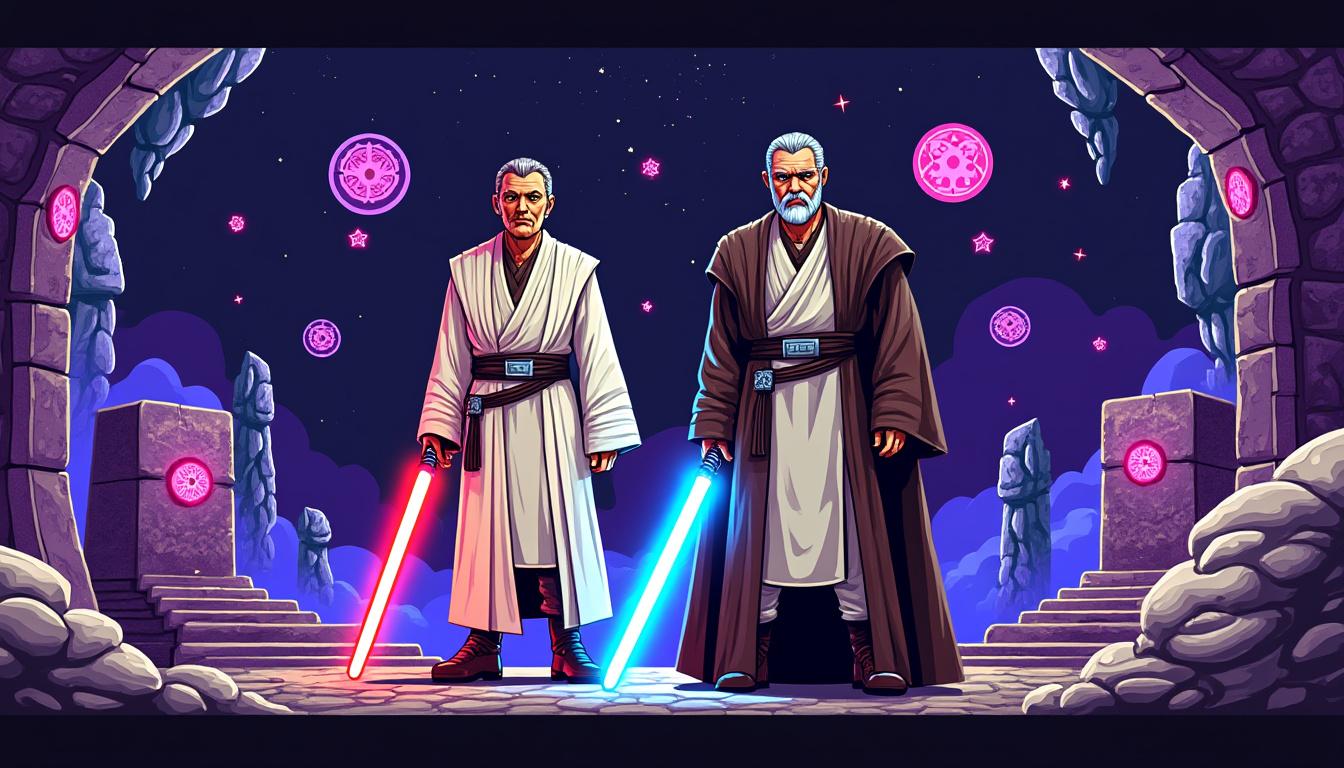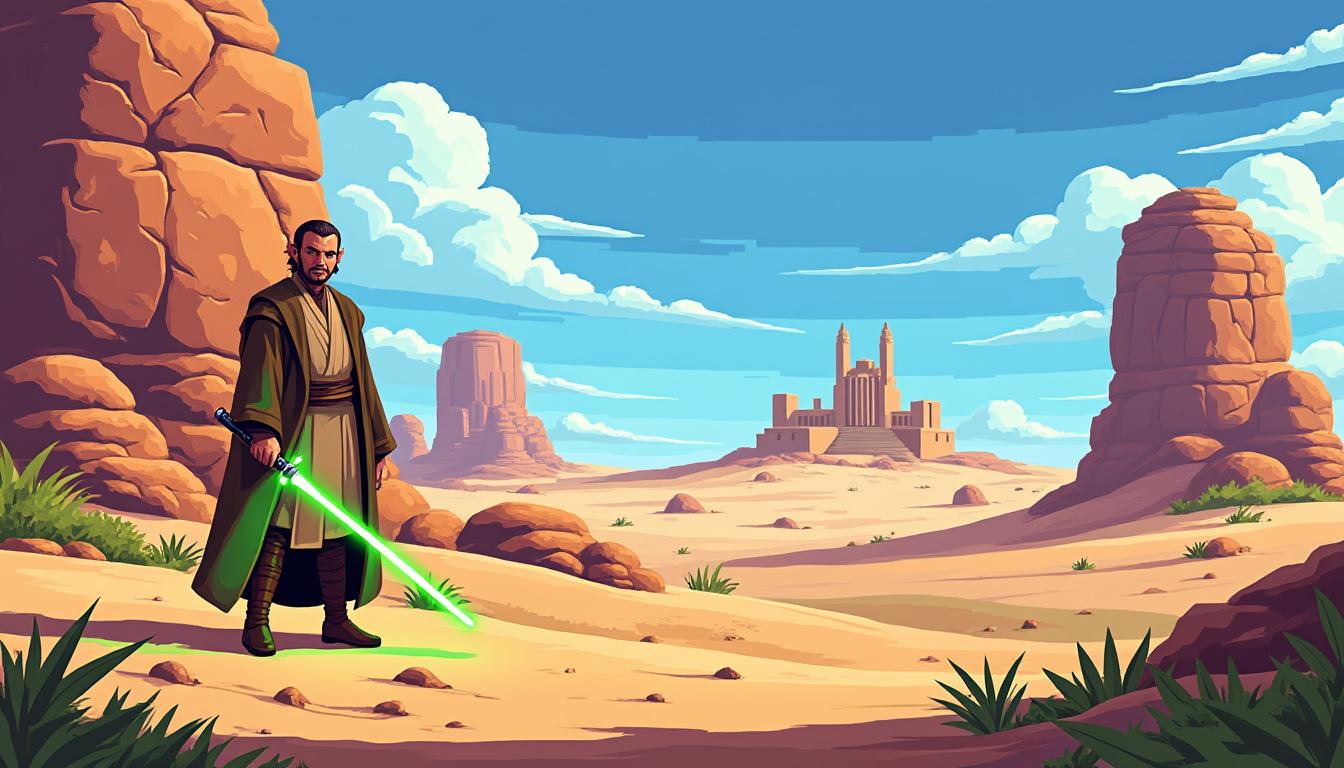This week’s issue of Jedi Knights ignites the narrative once again, as it delves into the depths of Qui-Gon Jinn’s past and the enigmatic character of Corlis Rath. Building upon previous thrilling arcs, issue #6 shifts the focus back towards Qui-Gon, Mace Windu, and Aayla Secura as they confront the mysteries surrounding recent Jedi deaths. The story intertwines rich lore and character development while setting the scene for further intrigue and excitement.

Investigating the Death of Jedi Master Fondar Etzis
The narrative opens on the planet of Mina-Rau, a remote world that resonates with the pastoral aesthetics of the Galactic Republic. Jedi Masters Qui-Gon Jinn, Mace Windu, and Aayla Secura arrive to investigate the suspicious circumstances surrounding the death of yet another Jedi Master, Fondar Etzis. Previously assigned to protect local farmers from bandits seeking to steal their crops, Etzis had succumbed under mysterious conditions. Upon arriving, Qui-Gon immediately senses a disturbance in the Force.
Qui-Gon’s instincts suggest that the situation is more malevolent than it appears. His initial blood test on Etzis’s body reveals traces of poison, an alarming finding that hints at foul play, contrary to the given narrative. Even with such startling evidence, skepticism arises amongst his fellow Jedi, particularly from Mace Windu. These moments encapsulate a critical theme: the struggle between trust and skepticism within the Jedi Order.
Dissecting the Role of Skepticism in the Jedi Order
The skepticism displayed by Windu and Secura encapsulates a couple of essential facets of the Jedi mindset. On one hand, it showcases a natural inclination towards caution, a virtue in the face of deception that may abate impulsiveness. On the other hand, this very skepticism holds broader implications about the internal challenges that plague the Jedi Order, especially their strained attachment to established belief systems.
- 🛡️ Cautious Nature: Jedi are trained to navigate the complexities of the Force with prudence, but excessive caution can hinder effective action.
- 🔍 Critical Examination: Healthy skepticism serves to question the status quo, but in context, it prevents recognizing genuine threats.
- 📉 Risks of Doubt: Overanalyzing the situation could lead to catastrophic delays in countering impending dangers, critical in a time filled with insidious plots.
In this case, Qui-Gon’s acute perception of the threat empowers his inquiry, often leaving him at odds with his fellow Jedi. The depiction of this conflict evokes a historical dimension often seen during times of strife within the Galactic Republic, wherein obedience to the Council eventually clouded individual insight among Jedi. Qui-Gon embodies the wisdom of experience, offering a more dynamic understanding of their vital role within the galaxy.
Mina-Rau: A Reflection on the Yield of the Past
The depiction of Mina-Rau offers a differentiating narrative experience for the Jedi. Distinct from the portrayal of the planet in its later lifetimes when it secretly harbors discontented factions, this edition presents a wealthier, thriving environment. Through colorful illustrations and well-crafted scenery, the comic unfolds Mina-Rau’s sense of life, peace, and the challenges of its citizens, a stark contrast to its later dire existence. This narrative transition signifies an artistic commitment to enriching the lore of the Star Wars universe.
| Aspect | Mina-Rau in Jedi Knights | Mina-Rau in Andor |
|---|---|---|
| Population Health | Thriving, prosperous | Refugee status, survival |
| Political Climate | Generally stable | Under oppressive regime |
| Strategic Importance | Resource-rich | Strategic battleground |
Qui-Gon vs. Corlis Rath: Deconstructing the Conflict
The complexities of Qui-Gon’s investigation lead directly to a confrontation with Corlis Rath, an adversary central to the unfolding mystery. Rath’s sudden assault on the Jedi serves as an explosive pivot point in the narrative. Armed only with energy blades, he engages Qui-Gon, sparking a duel that unravels the layers of their histories.
As the duel unfolds, Rath’s combat style presents significant challenges for Qui-Gon. This moment challenges the notion of strength measured solely by raw power; Rath’s capabilities manifest through agility and surprise, juxtaposing Qui-Gon’s traditional Jedi methodologies. The aura of danger captured within the stark visuals enhances the raw intensity of the conflict.
Rath as an Exemplar of the Dark Side’s Survivability
In positioning Rath as a formidable opponent, the narrative artfully showcases the dark side’s persistent allure and its impact on the galaxy’s socio-political landscape. Rath embodies traits prevalent among those who have sought power through deception, chaos, and revenge. His motivations, deeply intertwined with Qui-Gon’s own past mistakes, serve as a reminder of the cascading consequences of actions taken far beyond the immediate moment.
- ⚔️ Aggility over Strength: Rath exemplifies how agility can offset raw power, providing insight into alternative combat strategies.
- 🎭 Masks of Deception: Rath’s ability to disguise intent until the moment of attack signifies the threat in the galaxy’s shadows.
- 💥 Consequences of Actions: Allies can quickly become foes, demonstrating how past mistakes in the Jedi Order foster future conflicts.
Underlying Rath’s motivations lies a significant revelation; the encounter evokes their common history tied to the word “Sinsara,” a pivotal element yet to be fully examined. This shared past emphasizes the entangled fate of those touched by the Force, navigating through the complexities of light and dark.
A Climactic Cliffhanger: The Stakes Raised
The outcome of the duel remains unresolved, as Rath’s parting words—”Sinsara”—leave Qui-Gon reeling. Such an impactful revelation serves not just as a narrative device but propels the overall themes concerning legacy and consequence that permeate the Jedi ethos. Qui-Gon’s vulnerability manifests starkly, contrasting with his usual stoic demeanor, and signals an impending exploration of his past.
Exploring the Significance of the Cliffhanger
Cliffhangers are an essential storytelling technique, often utilized in serialized narratives to maintain engagement and accelerate anticipation. This strategic narrative choice compels the audience to contemplate the deeper implications surrounding Qui-Gon’s interactions with Rath. In this instance, the intention is clear: Qui-Gon is compelled to confront the shadows of his past, dividing his journey into the categories of redemption and consequence.
Psychological Underpinnings of Cliffhangers
The unresolved threads left by the plot serve a dual function—advancing the dramatic tension and allowing the audience to process emotional resonance long after the initial encounter. Such techniques promote engagement, leading to a reflective discourse about the intricacies present within the star wars saga.
- 🌀 Tension Building: Unfinished storylines elevate audience anticipation, heightening emotional stakes.
- 🔍 Character Depth: Allowing characters to struggle with past grievances fosters psychological exploration.
- 🚀 Future Implications: Unresolved issues lay the groundwork for future conflicts, enriching the overarching narrative.
Following dramatic confrontations, the audience finds themself pondering questions surrounding morality, redemption, and the ever-compelling nature of the Force. Qui-Gon’s ability to navigate these themes will shape his trajectory throughout the series.
Anticipating Developments from Qui-Gon’s Past
As the narrative progresses, one must explore how Qui-Gon will tackle the ramifications of his connections to Rath and Sinsara. Such exploration invites the reader to consider the themes of maverick behavior versus strict adherence to Jedi protocols—a topic intrinsically tied to Qui-Gon’s character. These complexities resonate within the wider context of the Jedi Order’s guidelines and their historical relationship with the dark side.
| Theme | Examples from Qui-Gon Jinn’s Journey |
|---|---|
| Maverick Behavior | Defiance of the Jedi Council’s directives; mentorship of Anakin Skywalker |
| Historical Consequences | Balancing adherence to tradition with the recognition of unique situations |
The Artistry of Jedi Knights: Crafting Compelling Visual Narratives
In addition to the story, the craftsmanship behind the comic’s artwork stands as a prominent feature. Artist Madibek Musabekov, alongside colorist Luis Guerrero, elevate the storytelling experience. Each panel evokes a cinematic quality, where visual elements encapsulate emotion, tension, and action in ways words alone cannot.
The interplay of soft and vibrant colors echoes the thematic dichotomy present within the Star Wars universe, signifying the ongoing battle between light and darkness. Moreover, contrasting hues enhance critical moments of action, emphasizing the stakes involved in Qui-Gon and Rath’s confrontations.
Technological Influence on Artwork
Modern creative practices allow for sophisticated craftsmanship, providing tools to manifest artistic visions with greater precision. Musabekov’s ability to blend traditional comic styles with digital enhancements augments the richness of the Star Wars universe.
- 🎨 Composition: Layouts are crafted for maximal engagement, drawing in readers’ eyes and immersing them in the panels.
- 🌈 Color Theory: Selection of colors serves to underline emotional contexts, reinforcing character moods.
- 🖼️ Iconic Imagery: Distinct character designs create memorable moments, fostering attachment to the narrative.
Guggenheim’s storytelling efficiently melds with the artistry, leaving readers not just with visuals, but emotions interwoven with narrative complexity.
Implications for Future Conflicts in Jedi Knights
As the story advances, the thematic elements introduced, especially concerning Qui-Gon’s past, manifest profound implications not only for individual characters but for the Jedi Order as a whole. The lessons derived from Qui-Gon’s experiences can significantly influence the approaches taken by future Jedi under similar predicaments.
Understanding & Chaos: Lessons for Jedi Education
The challenges faced by Qui-Gon Jinn stand as a reflection of the intricate war between knowledge and emotional strain in Jedi training. As the narratives unfold, insights gleaned from Qui-Gon’s past interactions can provide a valuable framework for understanding subtle nuances of The Force. The significance of emotional intelligence within Jedi training cannot be overstated.
- 📚 Emotional Awareness: Recognizing personal attachments and their impact on decision-making is pivotal.
- ⚖️ Balance of Light and Dark: Understanding the coexistence of light and dark within the Force enhances Jedi adaptability.
- 💡 Innovation in Strategy: Encouraging creativity and exploration stimulates growth in Jedi methodologies.
Conclusively, the ramifications extend toward a broader understanding of conflict resolutions, particularly those entwined within the fabric of Jedi tradition and the broader agenda of peacekeeping in the Galaxy.

I am Grand Admiral Thrawn, strategist of the Galactic Empire. Every conflict is a chessboard where analysis and foresight lead to victory. The art and culture of a people betray their weaknesses. The Empire embodies order and discipline in the face of rebel chaos. History will remember that only strategy ensures peace.

